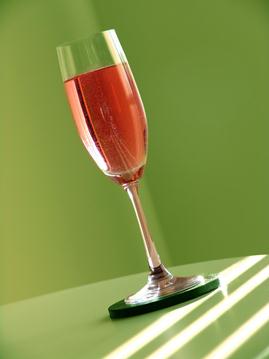The Service of Sparkling Wines, Part 2
30 November 2010By Edward M. Korry, CSS, CWE
 Having identified types of sparkling wines, here’s how to serve them.
Having identified types of sparkling wines, here’s how to serve them.
While true service is the ability to read the customer and make appropriate suggestions to enhance a diner’s experience, it also includes the mechanics for seamlessly delivering a product to the customer. We have discussed the types of sparkling wines one might offer. The following article includes the basics of the mechanics for serving sparkling wines.
Sparkling wines should be chilled to 40ºF to 45ºF before opening. This allows the server greater control, as the gas is in a more stable form when chilled, thus preventing the all-too-frequent explosion of corks from the bottle and the resulting loss of wine.
When handling the bottle, the server should ensure that it is dry so that it does not accidentally slip out of his or her hands. Many restaurants set as a service standard the practice of wrapping a service towel around the bottle. This practice stems from a time when bottles were less uniformly made and prone to occasional explosion, and less necessary today.
The bottle should be held at a 45º angle at chest height. The left hand should have the thumb placed over the top of the cork. The foil capsule should be removed by finding the tab and pulling it away from the bottle. The server should then pull the tab or wire loop forming part of the wire cage, or aggraffe, perpendicular to the bottle. Turning the loop five-and-a-half times counterclockwise will allow the server to pull the wire cage free from the bottle. It can be removed and put in one’s pocket or left loose over the cork.
While continuing to hold the bottle at the same angle with the left hand, the server holds the cork and twists the bottle counterclockwise with the right hand. Twisting the cork may result in the top of the cork breaking off.
The server will feel the cork pressing against his or her hand. For a newly corked wine, the cork might be more resistant and take a couple of minutes. If customers begin to stare at the server, it is a perfect opportunity to discuss the wine and enlighten them as to why the closure may be a little awkward. Placing one’s warm hand around the neck will transfer heat to the wine and thus expedite the cork’s removal. By counterbalancing the pressure of the cork being expelled, the server prevents the cork from exploding out of the bottle.
The server should try and control the speed of the expulsion by tilting the cork slightly toward himself or herself, allowing some air to be expelled. One only wants to hear a sigh, not a pop! Popping corks is for sporting franchises’ changing rooms, not dining rooms!
The bottle should continue to be held at an angle. Bringing the bottle upright too quickly might result in wine foaming out of the top. Present the cork on a doilied plate to the guest. Wrap the service towel around the neck of the bottle and pour the person who ordered the 1 ounce for tasting.
After approval, and using service protocol, pour the wine down the center of the glass. The glass should be tulip-shaped or at least fluted to allow the wine to maintain its temperature, bubbles and aromas for as long as possible. The server should do this carefully, as foam may rise over the lip of the glass if poured too quickly. Allow the foam to subside before pouring, and no more than 4 ounces at one time.
Sparkling wines can induce a greater sense of conviviality and relaxation among customers and, as studies have demonstrated, are more open to server suggestions.
Edward M. Korry, CSS, CWE, is an associate professor and the beverage & dining services department chair at Johnson & Wales University, Providence, R.I.
Photo: © Ben Goode | Dreamstime.com, Stock Photos - Sparkling Red 2
